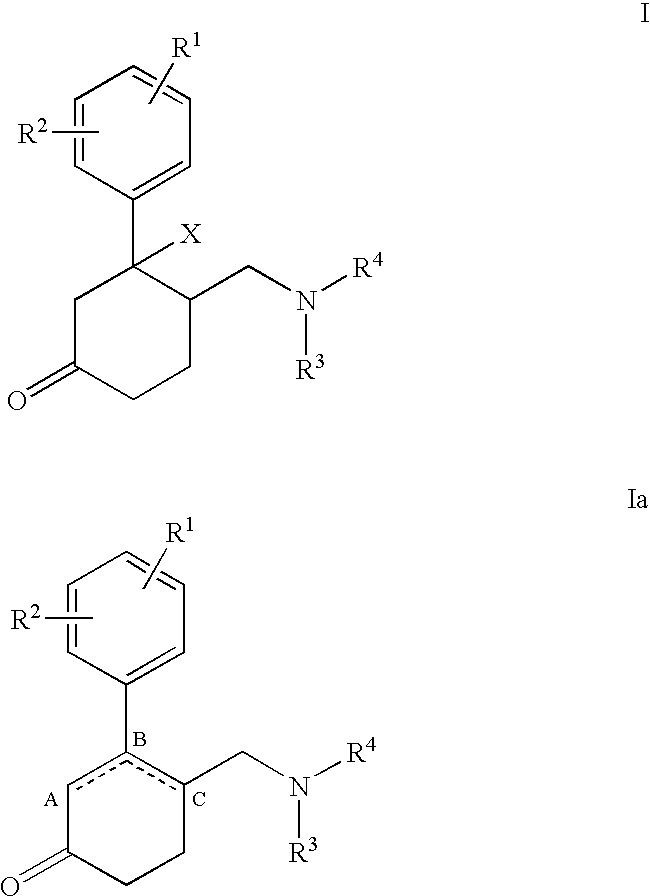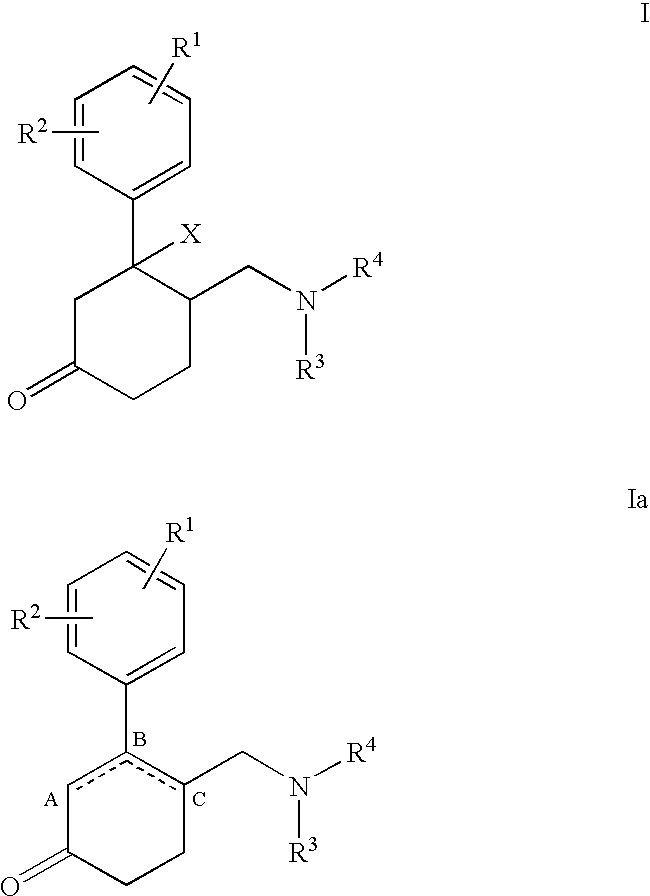Aminomethyl-phenyl-cyclohexanone derivatives
a technology of phenylcyclohexanone and derivatives, which is applied in the field of aminomethylphenylcyclohexanone derivatives, can solve the problems of limited use of these derivatives
- Summary
- Abstract
- Description
- Claims
- Application Information
AI Technical Summary
Problems solved by technology
Method used
Image
Examples
example 1
rac-cis-[4-Dimethylaminomethyl-3-hydroxy-3-(3-methoxy-phenyl)-cyclohexanone](compound 1) and 4-dimethylaminomethyl-3-(3-methoxy-phenyl)-cyclohex-2-enone (compound 6)
[0290]
Stage 1
3,3-Dimethyl-1,5-dioxa-spiro[5.5]undecan-8-one
[0291]
[0292]448.5 g 1,3-cyclohexanedione, 416 g 2,2-dimethyl-1,3-propanediol and 12 g p-toluenesulfonic acid were introduced into 3,000 ml methylene chloride and the mixture was heated under reflux for 24 hours using a water separator. When the reaction had ended the mixture was cooled to room temperature and 2,000 ml 32% sodium hydroxide solution were added. The phases were separated and the organic phase was washed first with sodium bicarbonate solution (44.4 g sodium bicarbonate solution / 850 ml water) and then with 350 ml water. The organic phase was dried over sodium sulfate and the solvent was then evaporated in vacuo. 345 g (50% of theory) 3,3-dimethyl-1,5-dioxa-spiro[5.5]undecan-8-one were obtained in this way.
Stage 2
9-Dimethylaminomethyl-3,3-dimethyl-1,5-...
example 2
rac-cis-[4-Dimethylaminomethyl-3-(3-methoxy-phenyl)-cyclohexanone]hydrochloride (compound 2) and rac-trans-[4-dimethylaminomethyl-3-(3-methoxy-phenyl)-cyclohexanone]hydrochloride (compound 3)
[0300]
[0301]28.5 g 4-dimethylaminomethyl-3-(3-methoxy-phenyl)-cyclohex-2-enone, which was prepared according to example 1 stage 4a), were dissolved in 250 ml absolute methanol. 2.8 g palladium-on-charcoal (10%) were added as a catalyst, while stirring and passing dry nitrogen over. Hydrogenation was then carried out for five hours under a pressure of 0.2 bar and at a temperature of 20° C. After filtration, the solvent was evaporated off in vacuo and the residue was purified by column chromatography on silica gel with ethyl acetate / methanol / diisopropyl ether=4 / 1 / 5 as the eluting agent. 7.5 g rac-cis-[4-dimethylaminomethyl-3-(3-methoxy-phenyl)]-cyclohexanone in the form of an oil were obtained as the first product fraction. To prepare the hydrochloride, the base was dissolved in acetone, and an eq...
example 3
rac-cis-[4-Dimethylaminomethyl-3-(3-hydroxy-phenyl)-cyclohexanone (compound 4) and rac-trans-[4-dimethylaminomethyl-3-(3-hydroxy-phenyl)-cyclohexanone (compound 5)
[0302]
Stage 1
8-[3-(tert-Butyl-diphenyl-silanyloxy)-phenyl]-9-dimethylaminomethyl-3,3-dimethyl-1,5-dioxa-spiro[5.5]undecan-8-ol
[0303]
[0304]17.3 g magnesium filings were initially introduced into tetrahydrofuran. 293 g (3-bromo-phenoxy)-tert-butyl-diphenylsilane in 150 ml tetrahydrofuran were then added dropwise (under gentle reflux). The mixture was allowed to after-react for 1 hour. 142 g 9-dimethylaminomethyl-1,5-dioxa-spiro[5.5]undecan-8-one, which was prepared according to example 1, stage 2, were then added dropwise at 20° C. The mixture was stirred at room temperature for 10 hours. Hydrolysis was then carried out at 10-15° C. with 200 ml 20% ammonium chloride solution and then with 500 ml water. The aqueous phase was extracted twice with 300 ml ethyl acetate each time. The combined organic phases were dried over magne...
PUM
| Property | Measurement | Unit |
|---|---|---|
| Temperature | aaaaa | aaaaa |
| Temperature | aaaaa | aaaaa |
| Temperature | aaaaa | aaaaa |
Abstract
Description
Claims
Application Information
 Login to View More
Login to View More - R&D
- Intellectual Property
- Life Sciences
- Materials
- Tech Scout
- Unparalleled Data Quality
- Higher Quality Content
- 60% Fewer Hallucinations
Browse by: Latest US Patents, China's latest patents, Technical Efficacy Thesaurus, Application Domain, Technology Topic, Popular Technical Reports.
© 2025 PatSnap. All rights reserved.Legal|Privacy policy|Modern Slavery Act Transparency Statement|Sitemap|About US| Contact US: help@patsnap.com



